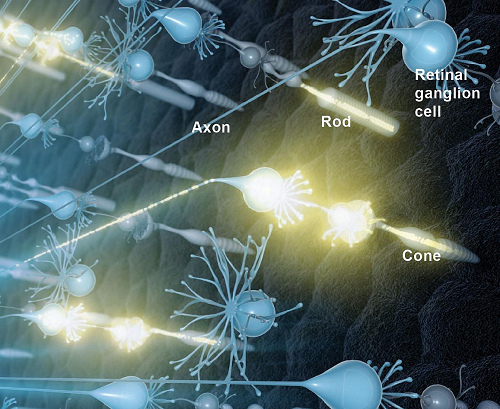Six teams seek to identify biological factors that influence neural regeneration
NIH to award $12.4 million over three years as part of audacious effort to reverse blindness.
The National Institutes of Health will fund six projects to identify biological factors that affect neural regeneration in the retina. The projects are part of the National Eye Institute (NEI) Audacious Goals Initiative (AGI), a targeted effort to restore vision by regenerating neurons and their connections in the eye and visual system.

Artist’s rendering of neural activity in the retina. Light that enters the eye activates rod and cone photoreceptors, which then activates retinal ganglion cells. A signal travels to the brain via the retinal ganglion cell axons.
“Understanding factors that mediate the regeneration of neurons and the growth of axons is crucial for the development of breakthrough therapies for blinding diseases. What we learn through these projects will have a health impact beyond vision,” said Paul A. Sieving, M.D., Ph.D., director of NEI, part of NIH.
Most irreversible blindness results from the loss of neurons in the retina, which is the light-sensitive tissue in the back of the eye. Many common eye diseases, including age-related macular degeneration, glaucoma and diabetic retinopathy, put these cells at risk. Once these neurons are gone, humans have little if any capacity to replace them.
These six projects will add to the knowledge base from several recent key advances. Researchers recently reported a technique that increases the regenerative capacity of retinal axons in a mouse model of optic nerve injury, a model commonly used to study glaucoma and other optic neuropathies. Progress also has been made in identifying factors that either stimulate or inhibit regeneration of neurons required for vision. The newly-funded projects will further this area of research by identifying cues that guide axons to appropriate targets in the brain, allowing functional connections to re-establish between the eye and the visual processing system.
Source: U.S. National Institutes of Health
- 264 reads
Human Rights
Fostering a More Humane World: The 28th Eurasian Economic Summi

Conscience, Hope, and Action: Keys to Global Peace and Sustainability

Ringing FOWPAL’s Peace Bell for the World:Nobel Peace Prize Laureates’ Visions and Actions

Protecting the World’s Cultural Diversity for a Sustainable Future

Puppet Show I International Friendship Day 2020

